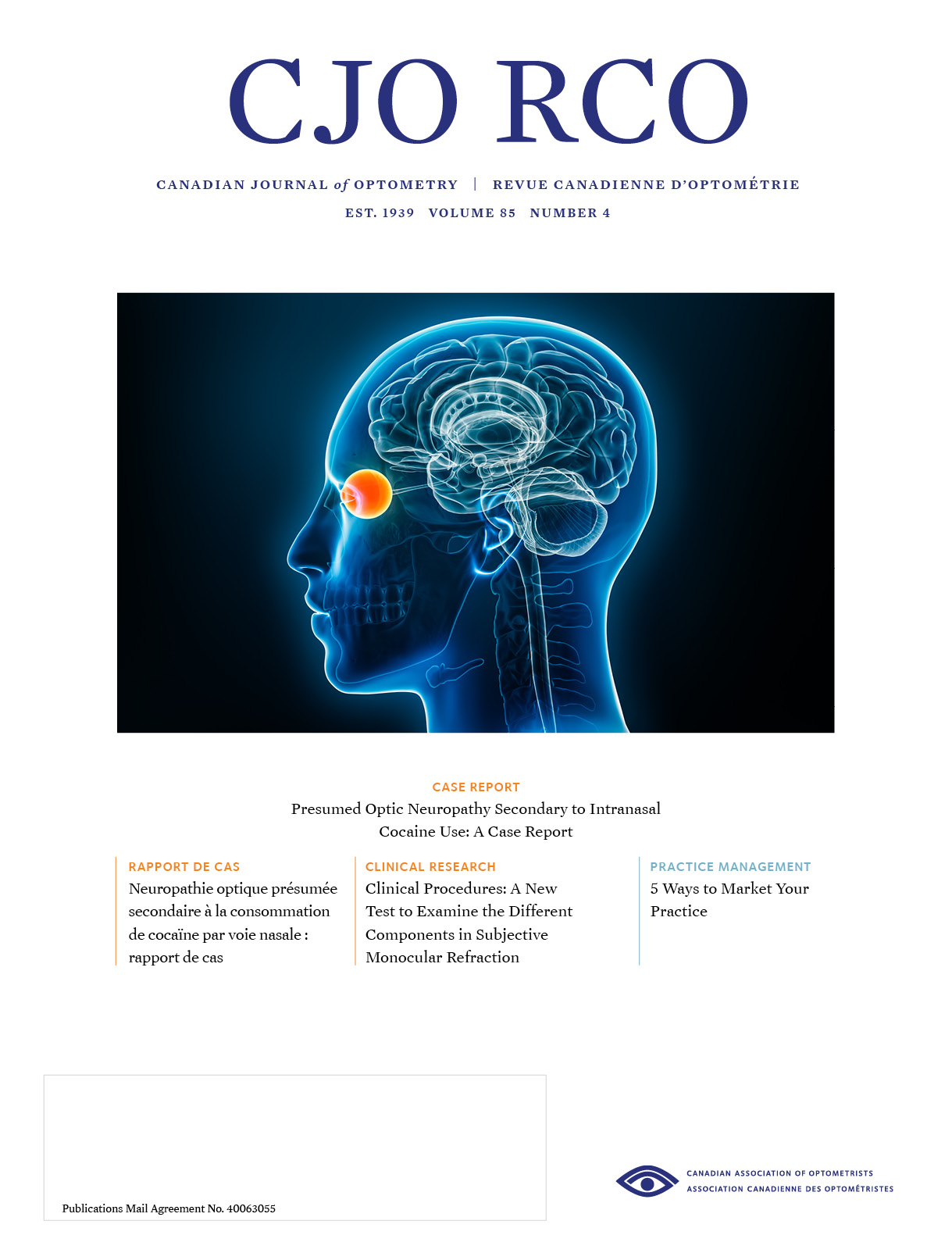Clinical Procedures: A New Test to Examine the Different Components in Subjective Monocular Refraction
DOI:
https://doi.org/10.15353/cjo.v85i4.5553Keywords:
Refractive errors, Subjective monocular refraction, Errors in viewingAbstract
Significance: Subjective monocular refraction is the basis for determining an optometric prescription. A single testing target for determining the final prescription, by simultaneous viewing with a method to control testing error, simplifies the procedure, since the patient has a better appreciation of the end-point and relates more easily to the examination.
Purpose: The purpose of this study was to identify a test chart and method of examination to improve the efficiency of determining the correction of the astigmatic and spherical components of a prescription. The testing procedure uses an immediate comparison and avoids sequential testing that relies on memory.
A method of avoiding errors, caused by looking away from the optical centre, is included.
This is important in cases of high prescriptions. This method may be suitable for ancillary staff to use in the introductory testing routine.
Method: A single, non-movable test chart, independent of the circle of least confusion, is presented. The target is based on the simultaneous resolution of a line in four meridians. A second chart is incorporated into the principal chart. This uses chromatic displacement caused by the off-centre viewing of a prism to avoid errors.
Result: This testing method, when used in the clinic, has been shown to be efficient and easily understood. A limited independent trial showed that the method is as effective as traditional methods and gives acceptable results when used by ancillary staff. The results obtained by non-experienced individuals are also presented. This may be useful in environments where no professional staff are available.
Conclusion: The method described here improves the examination of subjective refraction without the need to change targets. There is no need to consider the circle of least confusion. The target includes tests for axis, cylinder power, spherical power and duochrome. The use of a simultaneous comparison is better received by patients than the sequential test, and is easily understood. The spherical end-point is definite, unless there is hyper-acuity or accommodative spasm. The test improves the ability of the patient to understand, and be comfortable with, the testing method. Binocular balance is not considered here.
References
Jackson E. The Astigmic Lens (Crossed Cylinder) to Determine the Amount and Principal Meridians of Astigmia. Ophthalmol Rec 1907;17:378-83.
Rosenfield M, Logan N. Optometry: Science, Techniques and Clinical Management, 2nd ed. Oxford: Butterworth-Heinemann, 2009.
Bennett AG, Rabbetts RB. Clinical Visual Optics, 2nd ed. Oxford: Butterworths, 1996.
Goss DA, Grosvenor T. Reliability of Refraction. J Am Optom Assoc 1996; 67:619-30.
Johnson BL, Edwards JS, Goss DA, et al. A Comparison of Three Subjective Tests for Astigmatism and their Inter-examiner Reliabilities. J Am Optom Assoc 1996; 67:590-8.
Fannin TE, Grosvenor T. Clinical Optics 2nd ed. Oxford: Butterworth-Heinemann, 1996.
Bennett AG. An Historical Review of Optometric Principles and Techniques. Ophthal Physiol Optics 1986;3:21.
Westheimer G. Visual Acuity and Hyperacuity. Invest Ophthalmol Vis Sci 1975;14:570–2.
Shapiro J. Vision care in areas of under-developed infrastructure. J Public Health (Berl) 2020;28:4:393-9. doi: 10.1007/s10389-019-01031-1
Ray WA, O’Day DM. Statistical analysis of multi-eye data in ophthalmic research. Invest Ophthalmol Vis Sci 1985;26:1186–8.
Armstrong RA. Statistical guidelines for the analysis of data obtained from one or both eyes. Ophthal Physiol Opt 2013;33:7–14.
Published
How to Cite
Issue
Section
License
Copyright (c) 2023 Jonathan Shapiro

This work is licensed under a Creative Commons Attribution-NonCommercial-NoDerivatives 4.0 International License.


